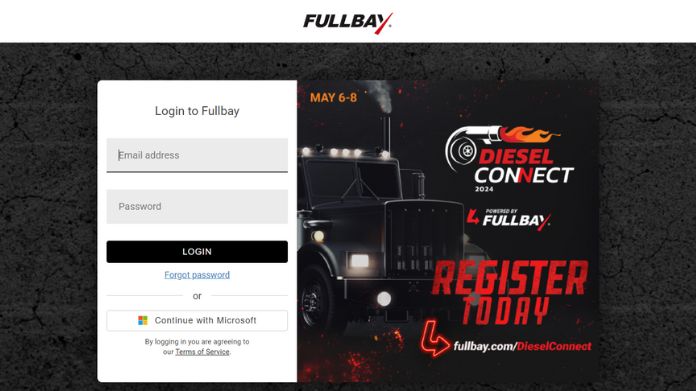Full Bay is a prominent software solution designed for heavy-duty truck repair, renowned for its efficiency-enhancing capabilities.
It has carved a niche in the market by providing a comprehensive, cloud-based management system tailored to the unique needs of repair shops and service centers.
Its significance lies in its ability to streamline operations, from work order management to invoicing, inventory tracking, and customer relationship management.
The Full Bay login process is a critical aspect of accessing these powerful tools and features.
It serves as the gateway for users to enter a secure, user-friendly environment where they can manage all aspects of their business operations.
A reliable and secure login process is essential, not just for the functionality it provides but also for protecting sensitive business and customer data.
In an industry where time is money and accuracy is paramount, the ability to quickly and securely log into Full Bay is paramount.
It ensures that users can efficiently manage their daily tasks, access crucial information in real-time, and maintain the high level of service essential in the heavy-duty repair industry.
Logintrick will cover everything from initial setup to login, ensuring you can access and make the most of Full Bay’s features with ease.
What is Full Bay?
Full Bay is a specialized software platform designed to cater to the heavy-duty truck repair industry, offering a suite of services that revolutionize how repair shops operate.
Its design specifically targets the needs of heavy-duty repair shops, making it a vital tool in a niche yet crucial sector.
Services Offered by Full Bay
- Work Order Management: Full Bay allows for efficient tracking and management of work orders, ensuring that repair jobs are completed in a timely and accurate manner.
- Inventory Management: The software provides robust inventory management features, enabling shops to keep track of parts and supplies, reducing the risk of overstocking or stockouts.
- Customer Relationship Management (CRM): Full Bay includes CRM capabilities to help shops manage customer information, communication, and service history, improving customer service.
- Invoicing and Billing: The platform streamlines the invoicing and billing process, making it easier and faster to bill customers and manage financial transactions.
- Reporting and Analytics: Full Bay offers detailed reporting and analytics tools, giving shop owners insights into their business performance and helping them make data-driven decisions.
Target Audience
The primary audience for Full Bay includes owners and operators of heavy-duty truck repair shops, as well as their technicians and administrative staff.
The platform is also beneficial for fleet managers who oversee maintenance and repair operations.
Unique Features and Benefits
- Customization for Heavy-Duty Repair: Unlike generic management software, Full Bay is tailored to the specific needs of the heavy-duty repair industry, dealing with the unique challenges and requirements of this sector.
- Real-Time Data Access: Full Bay operates in the cloud, allowing users to access real-time data anytime and anywhere, which is crucial for fast-paced repair environments.
- Increased Efficiency: By automating various administrative tasks, Full Bay significantly reduces the time and effort required to manage repair operations, allowing staff to focus more on service delivery.
- Improved Accuracy: With digital record-keeping and automated systems, the likelihood of errors in inventory, billing, and customer data is greatly reduced.
- Enhanced Customer Satisfaction: The CRM features enable shops to provide better customer service, fostering loyalty and repeat business.
- Scalability: Full Bay is scalable, catering to the needs of both small shops and large repair centers.
- Comprehensive Support and Training: Full Bay offers extensive customer support and training resources, ensuring users can maximize the benefits of the software.
Step-by-Step Guide to Full Bay Login

Step 1: Prepare for Login
- Preparation: Ensure your Full Bay login credentials are ready, typically including a username or email address and a password. If you are a first-time user, make sure you have completed the registration process.
Step 2: Access the Full Bay Website
- Action: Open your web browser and type in the official Full Bay website URL. Be cautious of typos to avoid phishing sites.
- Tip: Bookmark the official site for future ease of access.
Step 3: Locate the Login Section
- Action: Once on the Full Bay homepage, look for the login option. This is often a button or link labeled “Login,” “Sign In,” or something similar, frequently located in the upper right corner of the page.
- Visual Cue: There may be an icon resembling a lock or a key next to the login link, symbolizing security.
Step 4: Enter Login Credentials
- Action: Click on the login link to open the login page. Here, enter your username or email and password in the designated fields.
- Attention to Detail: Ensure accuracy in entering your details, paying close attention to case sensitivity and special characters in your password.
Step 5: Two-Factor Authentication (If Enabled)
- Action: If Full Bay uses Two-Factor Authentication (2FA), follow the additional security steps, which might involve entering a code sent to your email or phone or verifying through an authenticator app.
- Note: 2FA is an extra layer of security beyond your password and is highly recommended for protecting your account.
Step 6: Troubleshooting Login Issues
- Forgotten Password: Use the “Forgot Password” link to reset your password. This typically involves verifying your identity through your email.
- Account Locked: If your account gets locked due to multiple incorrect attempts, follow the site’s instructions, which might involve contacting customer support.
- Browser Issues: If the login page doesn’t display correctly, try clearing your browser cache, updating the browser, or using a different browser.
Step 7: Completing the Login
- Action: After entering your credentials (and completing 2FA if applicable), click the “Log In” or “Submit” button.
- Successful Login: You should now have access to your Full Bay dashboard or the main interface, where you can manage and access various features.
Step 8: Post-Login Best Practices
- Security Check: Regularly update your password and maintain good security practices.
- Log Out: Ensure you log out after each session, especially when using a shared or public computer.
A Step-by-Step Guide to Creating a Full Bay Account
Step 1: Visit the Official Full Bay Website
- Action: Open your web browser and go to the Full Bay official website.
- Tip: Make sure you’re on the correct website to avoid any security issues.
Step 2: Locate the Account Creation Section
- Action: On the homepage, look for an option that says “Sign Up,” “Create Account,” or similar.
- Description: This is usually prominently displayed and easy to find.
Step 3: Fill Out the Registration Form
- Action: Click on the sign-up link, leading to a registration form.
- Details to Provide: Enter the required information, such as your name, email address, company information, and any other required fields.
- Password Creation: Choose a strong, secure password. It should typically include a mix of letters, numbers, and symbols.
Step 4: Complete Any Verification Process
- Action: There might be a captcha verification or email verification step to confirm you’re not a robot and verify your email address.
- Email Verification: If required, check your email for a verification link and click on it to complete the registration process.
Step 5: Configure Your Account
- Action: Once your account is created, you may be prompted to configure additional settings or add more detailed information about your business.
- Details to Add: This could include business hours, services offered, staff information, etc.
Step 6: Confirm Account Creation
- Action: After completing all steps, you should receive a confirmation that your account has been successfully created.
Maximizing your Full Bay Experience
 Maximizing the benefits of the Full Bay platform involves leveraging its full range of features and services effectively.
Maximizing the benefits of the Full Bay platform involves leveraging its full range of features and services effectively.
Here are some tips and insights into the additional services, support, and resources available to users, which can help enhance their experience on the platform:
- Utilize Comprehensive Reporting Features
- Deep Dive into Analytics: Full Bay provides detailed reporting tools. Make regular use of these analytics to gain insights into your business operations, financial performance, and productivity.
- Custom Reports: Explore the possibility of customizing reports to focus on the metrics that matter most to your specific business needs.
- Take Advantage of Real-Time Data Access
- Stay Updated: Use Full Bay’s real-time data feature to keep track of operations, inventory, and customer interactions as they happen. This can aid in making timely decisions and responding quickly to business needs.
- Mobile Access: If Full Bay offers a mobile app or mobile-responsive design, use it to manage your business on the go.
- Streamline Inventory Management
- Automate Inventory Tracking: Use Full Bay’s inventory management tools to automate the tracking of parts and supplies. This helps in maintaining optimal inventory levels and reducing waste and storage costs.
- Vendor Integration: Check if Full Bay offers integration with parts vendors for easier ordering and inventory replenishment.
- Enhance Customer Relationships
- CRM Tools: Utilize the CRM capabilities of Full Bay to maintain detailed customer records, track service histories, and manage communications. This can lead to improved customer service and repeat business.
- Feedback and Follow-ups: Use the platform to send out feedback requests and follow-up communications to build stronger relationships with customers.
- Leverage Educational Resources and Training
- Training Materials: Make use of any training materials, tutorials, or webinars provided by Full Bay to ensure you and your team are using the software to its fullest potential.
- Stay Informed: Keep an eye out for any updates or new features and learn how to use them effectively.
- Explore Integration Options
- Third-Party Integrations: Full Bay may offer integrations with other tools or platforms (like accounting software). Integrating these can streamline your workflow and increase efficiency.
- Engage with the Full Bay Community
- Forums and User Groups: Participate in Full Bay user forums or online communities. These can be valuable resources for tips, advice, and shared experiences.
- Utilize Customer Support
- Support Channels: Utilize Full Bay’s customer support for any technical issues or questions about the platform. This may include email support, live chat, or a helpline.
- Feedback Loop: Provide feedback to Full Bay about your experience and any features you’d like to see. User feedback can be instrumental in shaping future updates.
- Regular Updates and Upgrades
- Stay Updated: Keep your software up to date to benefit from the latest features and security enhancements.
- Implement Best Security Practices
- Secure Use: Follow best practices for data security and privacy to protect your business and customer information.
By fully engaging with these aspects of Full Bay, users can streamline their operational processes and enhance their overall business strategy and customer service.
It’s important to continually explore and utilize the full range of tools and resources offered by Full Bay to stay competitive and efficient in the heavy-duty repair industry.
